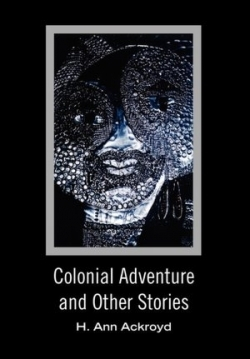Colonial Adventure and Other Stories
The brutal war that put an end to British colonialism in Southern Africa is the subject of the first of H. Ann Ackroyd’s free-form verse stories in her collection, Colonial Adventure and Other Stories. Set during the years 1936 to 1977, “Colonial Adventure” addresses the toll taken on both sides of the racial divide during the rise of black nationalism. Ackroyd tells the tale of a British couple’s struggles, triumphs, and eventual downfall as they establish, and later lose, a large-scale agricultural operation in southern Africa. Through her memorable and deftly-drawn characters and their complex, passionate relationships set against the backdrop of Rhodesia’s bloody civil war, she gives readers a visceral experience of the destruction of an entire way of life and the customs, attitudes, and entitlements that had maintained it.
The free-verse form has served the author well in this story, allowing her to transmit its essence in a distilled form. Stripped of all excess verbiage, the narrative is intense and captivating, and Ackroyd skillfully conveys worlds of emotion with minimal means. Her inclusion of black-and-white photographs of African art, the landscape, and several of the places mentioned in the story enhance the reading experience, and help to emphasize the sense of “otherness” that white colonists in a country with a black majority must surely have felt.
The other stories in the collection, also in free verse, continue to touch upon human emotion in a style at once spare and replete with information. “Haitian Girl” tells of the 1980 hurricane that devastated the island nation, killing a young girl’s father and leaving her, her siblings, and her mother with nothing. Inspired to create a proper habitat for her people, Lucille studies architecture and returns to Haiti with her white lover, but her plans to help her people are stalled by bureaucratic corruption and voodoo. They plan to leave the island but are caught up in the massive earthquake of 2010, with disastrous results. Here the writing loses some of the easy flow and rhythm present in the first story, which is also the case with the rest of the works in the volume.
“Actor” tells of a retired actor attempting to make peace with the ravages of old age; “Truncated” is the tale of a small boy abandoned by his mother at the Norfolk County Fair; “Persian Rug” offers apology for the fear of Islam that leads to injustice, while “The Veil” shows why such fears have come to be; and “Simba Kubwa Speaks,” the self-justifying monologue of an African dictator, gives a glimpse into the twisted logic and engorged ego that blinds such rulers to the suffering they cause. Ackroyd demonstrates a sharp eye for human weakness in theses stories of human suffering, confusion, and seeming hopelessness.
“Colonial Adventure” is the real gem of this volume; finely crafted and intense, it easily overshadows its companions. Unfortunately, no credit is given to those whose visual art enhances the text. While sculptor Isaac Masenda is mentioned in the story, he is not clearly identified as the creator of the beautiful works pictured. The photographs included are grainy, and the few typographical and word usage errors in the text would easily be remedied with additional proofreading.
H. Ann Ackroyd was born and raised in southern Africa and has lived in Europe and Brazil. She and her husband now live in Ontario, Canada.
Reviewed by
Kristine Morris
Disclosure: This article is not an endorsement, but a review. The publisher of this book provided free copies of the book and paid a small fee to have their book reviewed by a professional reviewer. Foreword Reviews and Clarion Reviews make no guarantee that the publisher will receive a positive review. Foreword Magazine, Inc. is disclosing this in accordance with the Federal Trade Commission’s 16 CFR, Part 255.

